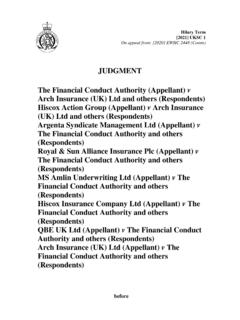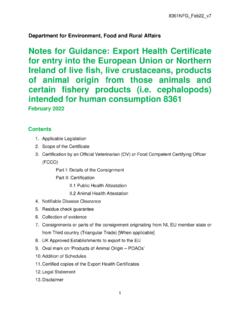Transcription of Contingency Plan for Exotic Notifiable Diseases of Animals ...
1 Contingency Plan for Exotic Notifiable Diseases of Animals in England Including Foot and Mouth Disease, Avian Influenza, Newcastle Disease and all other Exotic Notifiable Diseases of Animals Updated on 19 July 2021 Presented to Parliament pursuant to Section 14A of the Animal Health Act 1981 (as amended by Section 18 of the Animal Health Act 2002) Contingency Plan for Exotic Notifiable Diseases of Animals in England Including Foot and Mouth Disease, Avian Influenza, Newcastle Disease and all other Exotic Notifiable Diseases of Animals Presented to Parliament pursuant to Section 14A of the Animal Health Act 1981 (as amended by Section 18 of the Animal Health Act 2002) Updated on 19 July 2021 Crown copyright 2021 This publication is licensed under the terms of the Open Government Licence except where otherwise stated.
2 To view this licence, visit Where we have identified any third-party copyright information you will need to obtain permission from the copyright holders concerned. This publication is available at Any enquiries regarding this publication should be sent to us at Animal and Plant Health Agency Contingency Planning Team Seacole Building 2 Marsham Street London SW1P 4DF Email: PB 14664 ISBN: 978-1-5286-2707-8 CCS0621746322 Printed on paper containing 75% recycled fibre content minimum Printed in the UK by the APS Group on behalf of the Controller of Her Majesty s Stationery Office Contents Part A .. 1 Ministerial foreword .. 1 Introduction .. 2 About this plan .. 2 Legal background .. 3 Principles of disease control .. 5 Strategy and priorities .. 5 Access to the countryside .. 5 Disease control strategies.
3 5 International controls and trade implications .. 6 Suspicion and Confirmation .. 8 Suspicion of disease .. 8 Animal, premises and area restrictions .. 8 Confirmation of disease .. 14 Changes to movement controls .. 16 Enforcement .. 17 Command, control and communication (C3) structures .. 18 Strategic .. 21 Strategic / Tactical - National Disease Control Centre (NDCC) .. 21 Tactical / Operational - Central Disease Control Centre (CDCC) .. 32 Operational - Forward Operations Base (FOB) .. 34 Operational partners, other government departments and stakeholders .. 36 Environment Agency (EA) .. 36 UK Health Security Agency (UKHSA) .. 36 National Police Chiefs Council (NPCC) .. 36 Individual police forces .. 37 National Animal Health and Welfare Panel (NAHWP) .. 37 Local Authorities (LAs) and the Local Authority Animal Health Function (LAAHF).
4 37 Department of Health and Social Care (DHSC) .. 38 Cabinet Office, Civil Contingencies Secretariat (CCS) .. 38 United Kingdom Mission to the European Union (UKMis) .. 39 Ministry of Housing, Communities & Local Government (MHCLG) .. 39 Department for Transport (DfT) .. 39 Food Standards Agency (FSA) .. 39 Natural England (NE) .. 40 Devolved governments .. 40 Core groups .. 40 Stakeholders .. 40 Groups and committees .. 41 Cabinet Office Briefing Rooms (COBR) .. 41 National Security Council (NSC) .. 42 Science Advisory Council Exotic Disease subcommittee (SAC-ED) .. 43 Scientific Advisory Group for Emergencies (SAGE) .. 43 Defra Executive Committee (ExCo).. 44 Animal Disease Policy Group (ADPG) .. 44 Communications meeting .. 45 Strategic stocktake .. 45 National Experts Group (NEG) .. 46 Outbreak Advisory Group (OAG).
5 46 Core groups .. 47 Stakeholder 47 Bird-table meetings .. 47 Management teleconferences .. 48 Battle rhythm .. 48 Operations and logistics .. 50 Contracts, framework agreements and finance .. 50 Depopulation (culling) .. 50 Disposal policy and arrangements .. 52 Valuation and compensation .. 54 Cleansing and disinfection .. 54 Vaccination .. 56 Restoration of disease freedom and recovery .. 62 OIE terrestrial animal disease code .. 62 Regionalisation .. 62 Compartmentalisation .. 63 Restocking .. 63 Scaling down debriefing and lessons identified .. 64 Restoration of normal operations and recovery .. 64 Part B Emergency preparedness .. 66 Introduction .. 66 Working in partnership awareness and responsibility sharing .. 66 Pathways for introduction of disease .. 67 Readiness and resilience .. 68 Defra emergency preparedness.
6 68 APHA emergency planning and operational 68 Local emergency planning .. 69 Operational instructions .. 71 Training .. 71 APHA field veterinary staff .. 71 APHA technical 71 APHA staff involved in finance or procurement .. 72 APHA administrative staff .. 72 APHA administrative, field and technical staff .. 72 Veterinary Delivery Partnership (VDP) Official Veterinarians .. 72 Exercises .. 73 Local exercises .. 73 UK/GB exercises .. 73 Assurance .. 74 Emergency Readiness Management Assurance Scheme (ERMAS) .. 74 Equipment and stores .. 74 Provisions of stores and equipment at national level .. 74 Local minimum stocking levels .. 75 Laboratory capacity .. 75 Staff resourcing and finance .. 76 Government veterinary resources .. 76 Non-government veterinary personnel - emergency veterinary personnel .. 76 Non-government veterinary personnel temporary staff.
7 76 Overseas government staff .. 76 Technical, administrative and policy staff .. 76 Annex Summary for animal keepers .. 78 Introduction .. 78 Vigilance and biosecurity .. 78 Animal keeper responsibilities .. 79 Actions if disease is suspected or confirmed .. 79 On suspicion .. 79 On confirmation .. 81 Movement controls and licences .. 82 Licensing .. 82 Welfare moves .. 83 Regionalisation .. 83 Communications .. 83 Depopulation .. 84 Valuation and compensation .. 84 Cleansing and disinfection .. 85 Compartmentalisation .. 85 Restocking .. 85 Vaccination .. 86 Preparations in England .. 86 Trade, import and export .. 87 Glossary .. 88 1 Part A Ministerial foreword The Department for Environment, Food, and Rural Affairs (Defra) is committed to ensuring the United Kingdom (UK) remains a world-leading food and farming nation based on our high standards for animal health and welfare.
8 As a part of this, one of our main objectives is to ensure our country is well protected against animal and plant health risks. Defra takes the lead in England for planning and responding to outbreaks of Exotic disease in Animals . Exotic animal Diseases , that is Diseases which are not normally present in the UK, are a constant presence in various countries worldwide and becoming newly established in others. While the risk of these Diseases infecting Animals in the UK is usually low, the outbreaks of avian influenza during the 2020/21 winter serve as important reminders that the threat of a new outbreak occurring in the UK is ever-present and cannot be completely eliminated. As a department we have considerable experience in managing outbreaks of varying size and scale. Government, veterinary professionals, the farming and related sectors and all those keeping Animals , whether as a pet, a hobby or commercially, have a role to play in preventing and responding to disease.
9 This Contingency plan describes how Defra prepares for and responds to outbreaks. It provides for a swift, effective and coordinated response to control and eradicate disease, demonstrate official disease-free status and restore international trade. This 2021 edition has been updated with necessary amendments following the UK s exit from the European Union and addresses how a response would be managed under Covid-19 restrictions. The plan is presented in three sections, each with a specific focus: Part A How government will respond to and manage an outbreak including the organisational, command and control structures and disease control principles Part B How government prepares to respond to Exotic disease outbreaks Annex A summary for animal keepers, highlighting their responsibilities, good practice and actions government will take so that animal keepers can prepare Disease outbreaks cause Animals to suffer, damage businesses and cost the UK taxpayer significant sums of money.
10 Although we do everything we can to keep disease out, we must be fully prepared to deal with it if it occurs. We all have a shared responsibility to ensure that if disease occurs it is diagnosed early, that good management practices ensure that the risk of further spread is minimised, the outbreak is controlled and disease is eradicated. Lord Benyon - Parliamentary Under Secretary of State for Rural Affairs and Biosecurity 2 Introduction About this plan 1. This document describes how the government will manage an outbreak or incident of Exotic Notifiable disease of Animals including poultry in England. Exotic Diseases are those which are not normally present in the country. This plan will be invoked for Diseases in kept Animals (including companion Animals /pets). The principles will also be followed for certain Diseases in wild Animals , for example with specific strains of Avian Influenza (AI) in wild birds.













